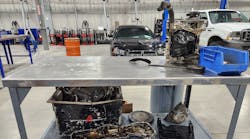Efficient fleet operation leads to increased revenue. In order to make loading and unloading cargo more efficient, fleets may choose to utilize a liftgate on its vehicles but there are several fundamental factors to consider before making a liftgate purchase, including:
- Where will the lift be mounted?
- How will the lift be used?
- How frequently will it be used?
Additionally, Kyle Decker, regional sales manager at Anthony Liftgates, says vehicles with lower GVWRs typically require a smaller liftgate because of the weight of the liftgate itself and the cargo being loaded in the vehicle. Anthony Liftgates (www.anthonyliftgates.com) is a producer of hydraulic truck liftgates.
Figuring out where to begin can be difficult. A best practice is to start by understanding what types of liftgates are available and how each kind functions.
STYLES
There are a number of common liftgate designs available. The four basic types are:
- Folding lifts – often referred to as tuckunder or stowaway lifts.
- Direct rail lifts – also known as column lifts.
- Cantilever lifts – sometimes called conventional liftgates.
- Sliders – also called under-sliders.
Folding gates are useful for small and medium duty chassis because it’s convenient to have the gate mounted underneath the body or bed of the chassis, says Mike Doerfler, regional sales manager with Palfinger Liftgates (www.palfinger.com) – a manufacturer of truck equipment, including lifts, cranes, hoists and platforms. This keeps rear doors accessible.
“A folding liftgate accommodates a wide array of platform depths, widths and lift capacities despite its compact size when stowed,” he says.
Designed for greater lift capacities and larger platforms, direct rail lifts and cantilever lifts are mounted at the rear of the truck body or trailer. Under-slider liftgates have a similar lifting capacity, but can provide more features, such as tilt functions, rear-door access and additional platform surface area.
“Cantilever liftgates offer the broadest lift capacities, bed height configurations and user features, and provide optimal tilting function,” says Doerfler. “Slider gates are more broadly accepted in European markets than domestically, but demand is growing.”
What’s more, side door gates – sometimes referred to as side-loader liftgates – are growing in popularity. Doerfler says the food and beverage industry is particularly fond of side-loaders, which are constructed similarly to under-slider gates but must be engineered more carefully due to the restricted mounting area on the side of a truck body. Side-loaders also can pose a tipping hazard if not engineered properly.
CAPACITY REQUIREMENTS
When selecting a liftgate, it is crucial to understand the device’s limitations. All types of liftgates can be mounted on the rear of a vehicle, explains Anton Griessner, vice president of marketing and business development at Maxon Lift (www.maxonlift.com) – a producer of liftgates and related equipment. However, several key factors should be considered – most importantly, capacity.
“The capacity needs to be specified for the heaviest load situation ever encountered – even if this only happens five times per year,” he advises.
He says another common mistake when calculating capacity requirements is only considering the load. Often, the weight of packaging materials – like pallets, loading devices like pallet jacks and the weight of the operator – get overlooked.
“These factors quickly add another 1,000 lbs to the required lifting capacity,” Griessner says, noting an electric pallet jack can weigh up to 800 lbs by itself.
What’s more, adds Palfinger’s Doerfler, it’s important to understand where on the platform surface area the primary weight of the load will be placed.
“The load and lift capacity on the tip of a folding liftgate will not support as much weight as the center of the platform,” he says. “It’s always better to assume the platform will be overloaded than otherwise. This also preserves and extends the life of the hydraulic and electrical power systems used to lift the platform and its contents.”
KEY CONSIDERATIONS
When spec’ing a liftgate, remember to factor the following into the decision:
- Truck bed height.
- Dock loading capability.
- Anticipated duty cycle of the liftgate.
- Weather/Climate conditions.
“Bed height clearly narrows the choice to certain gates,” says Maxon’s Griessner. “Certain gates only work for a small bandwidth of bed heights. Other gates are made for extremely low or high bed heights.”
Knowing whether or not loading or unloading will occur at a dock is another important factor when selecting an appropriate liftgate.
“Folding gates do not prohibit any type of door design or dock loading, but the built-in feature of the dock extension used when installing a folding liftgate will – if not properly mated to the dock height required,” says Palfinger’s Doerfler.
He adds that cantilever gates are not well suited for dock-to-dock transport; direct rail liftgates must be lowered to permit use at a dock; smaller rail lifts can be equipped with dock height capabilities for low bed height chassis delivering at dock environments; and under-slider gates do not interfere with dock deliveries.
When it comes to duty cycle, Anthony Liftgates’ Decker explains if the end user is running many cycles with the engine shut off, auxiliary battery boxes equipped with deep cycle or AGM batteries may be needed to maintain necessary electricity for the gate to function properly.
“In addition, an adequate charging system to recharge the auxiliary batteries while the engine is running between stops is just as important,” he says.
WEATHER
Because ambient temperature and corrosive environments can affect the operation and life expectancy of a liftgate, consider the weather and climate conditions a fleet operates in.
“Extreme temperature climates can tax the electric power supply and affect the performance of the hydraulic components used to operate the liftgate,” says Palfinger’s Doerfler. “Choosing a ‘power-down’ option on the liftgate, over a typical ‘gravity-down’ feature, may help speed the lowering operation of the gate under extreme cold conditions.”
He notes, however, that can shorten the life of the pump and motor. So in more temperate climates, it’s an unnecessary feature. “Some liftgate designs come with a ‘user optional’ power- or gravity-down feature, which, when used judiciously, will preserve the service life of the liftgate,” Doerfler says.
Where the unit is housed and whether a gate should be painted or galvanized are other decisions influenced by weather and climate conditions.
PLATFORMS
When it comes to choosing a platform, the choice of material comes down to steel or aluminum. Aluminum offers weight savings and corrosion resistance, but is more expensive at the time of purchase. Steel is easier to repair in case of damage.
Palfinger’s Doerfler says there are level ride platforms and true level ride platforms. While they sound similar, there are differences that can affect applications.
“A level ride platform tilts to meet the surface of the ground, and then ‘comes to level’ as the platform is raised – typically about 6” to 8” above the surface – and maintains level to the bed of the truck,” he explains. “A true level ride platform remains flat to the surface. The disadvantage of a true level ride platform is that it does not offer the ‘tilt’ feature of a level ride gate that sometimes improves surface contact when deployed on inclined surfaces.”
Additionally, there are wedge platforms and ramped platforms. According to Decker of Anthony Liftgates, a wedge platform works well for pallet jacks and carts. However, the load area of the platform is slightly sloped, which can sometimes be viewed as a drawback. A ramped platform is the least expensive option, but he notes it can be difficult to use pallet jacks and carts with this style.
Decker says other considerations when spec’ing platform size include:
- Container size.
- Weight capacity.
- Space needed for pallet jacks or personnel handling the cargo.
- Cart stops, if necessary.
SERVICE AND MAINTENANCE
Like any component of a vehicle, regular maintenance will keep a liftgate operating at peak efficiency.
For many liftgates, regular lubrication and greasing at each preventive maintenance (PM) interval is required. However, some liftgates are equipped with grease-free bushings that do not require lubrication.
According to Decker of Anthony Liftgates, 75 percent of liftgate downtime is related to the electrical system. To avoid these issues, he advises users to:
- Ensure connections are tight and clean.
- Verify cords are in good condition – not cut, smashed, abraded, etc.
“Additionally, all bare type electrical termination points – such as battery terminal lugs, etc., should also be sprayed with an insulating protective type spray after they are clean and free of corrosion,” says Maxon’s Griessner.
“Auxiliary batteries that are powering the liftgate motor should be charged up at every PM and load tested,” he adds. “A voltage drop test should be performed on any liftgate power or recharge circuit if one is experiencing a lot of failures with electrical components, such as electrical motors or motor solenoids.”
Some models of liftgates have spin-on type automotive filters that require changing annually or at intervals prescribed by the OEM. Hydraulic oil also should be topped off as needed.
RESEARCH
As with any capital purchase, a fleet should properly research all aspects of liftgates to determine the best option for its needs.
“Gate configuration assistance and technical support are also available from industry specialists employed by liftgate manufacturers,” says Palfinger’s Doerfler.
“Industry shows offer a great opportunity to tap into the experience of fellow liftgate users,” adds Maxon’s Griessner.
Major manufacturers provide online and physical resources – including brochures, videos, spec sheets, parts, warranty information and aftermarket materials – to help fleets make the right selection.




